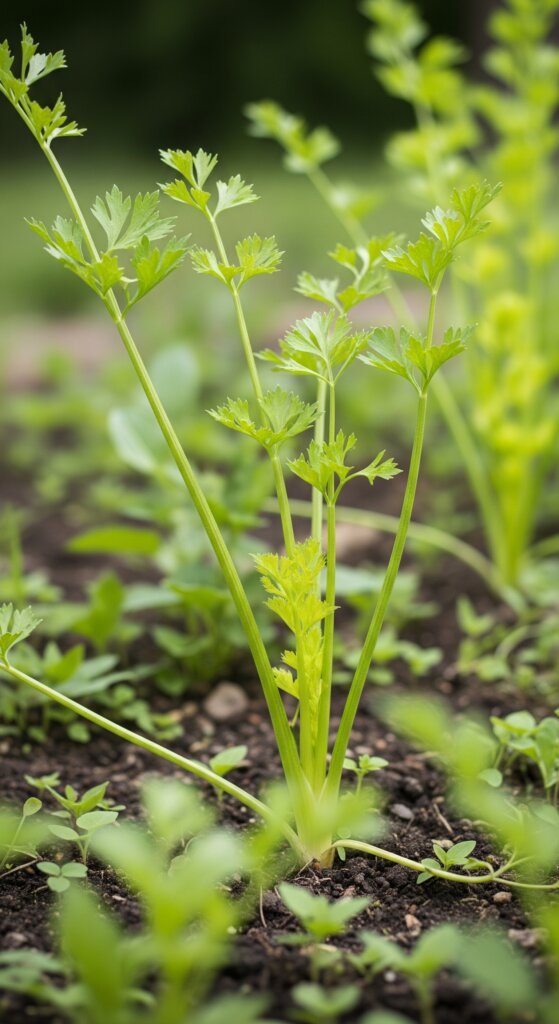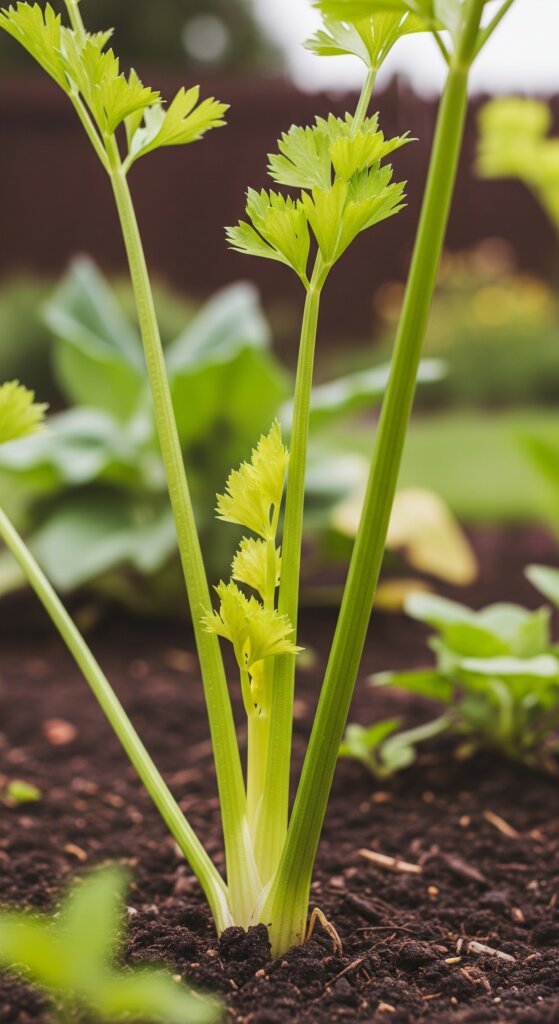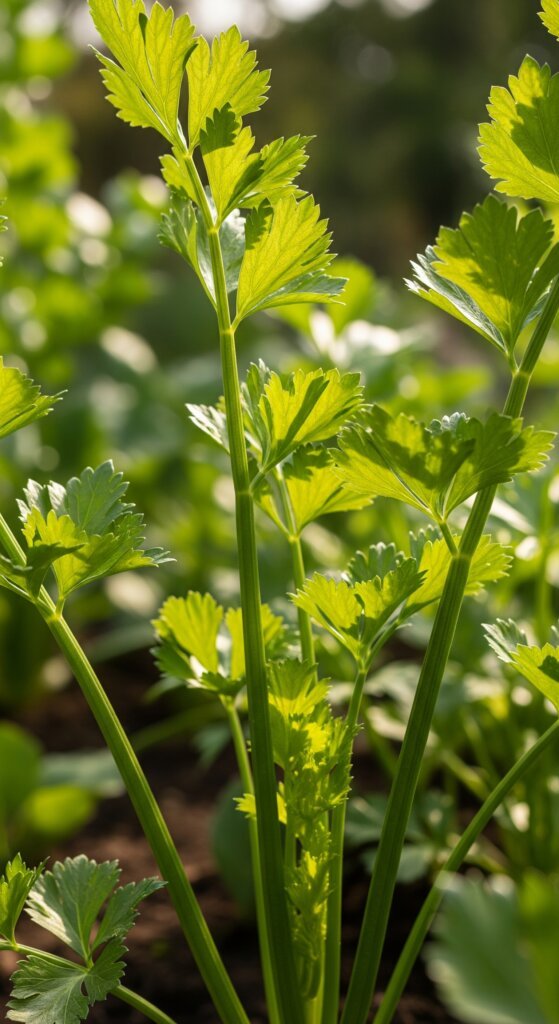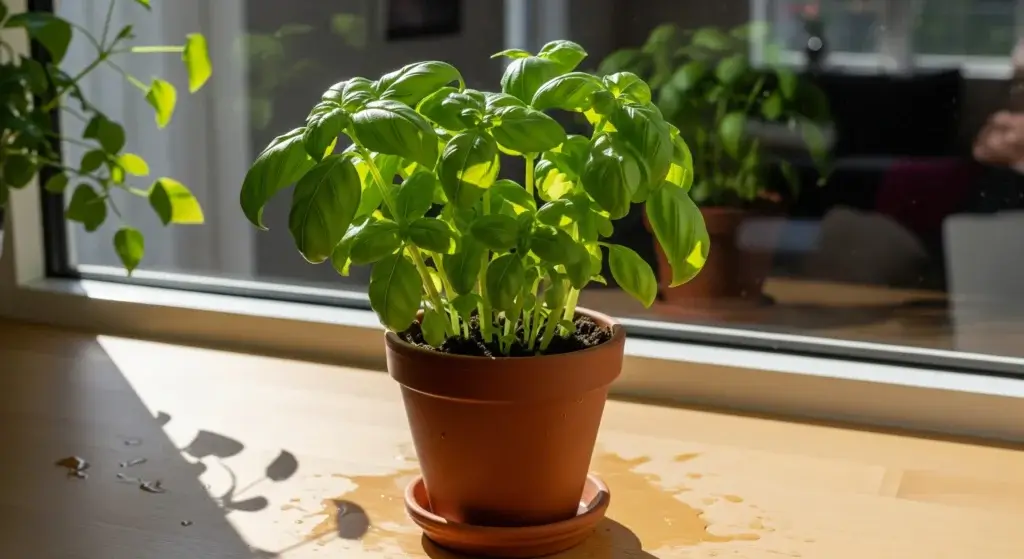
Growing celery sounds cool—until it shows up looking like soggy green noodles instead of crisp, crunchy stalks.
If your celery’s giving sad-salad vibes, don’t panic.
Celery is basically the Goldilocks of veggies: picky about water, sun, and timing.
But once you get the hang of it, those flimsy stalks can turn into the kind of crunch you brag about in group chats.
Let’s fix your celery drama and get those stalks thicc.
Why Does Celery Need Special Attention?
Celery’s not your low-maintenance veggie BFF.
It’s more like that high-maintenance friend who texts “I’m outside” but still expects you to open the door and carry their stuff.
Technically speaking, celery (aka Apium graveolens) is a cool-season biennial, which means it loves long, mild weather—not heat waves or frosty drama.
It wants rich soil, constant moisture, and lots of patience.
Skip any of that, and instead of thick, crunchy stalks, you’ll get sad, stringy ones.
The upside? Most celery meltdowns are totally fixable.
A few tweaks to your setup and your celery will go from “meh” to “more, please.”
7 Common Reasons Your Celery Stalks Are Thin
1. Inadequate watering
Celery is basically crunchy water—it’s 95% H₂O.
So if you’re slacking on the watering, it’s gonna throw shade with limp, bitter, hollow stalks.
How to tell it’s thirsty:
- Leaves wilting like they just gave up
- Stems feeling hollow and tough (no crunch, all sadness)
- It tastes like bitterness and regret
Fix it:
Give it a consistent drink—aim for 1 to 1.5 inches of water a week.
Keep that soil moist (not soggy), and slap on some mulch to hold in moisture like a cozy blanket.
Pro tip: No “droughts and floods” drama. Celery loves chill, steady vibes.
2. Insufficient nutrients
Celery’s a total nutrient hog.
If your soil’s not feeding it right, it’ll stay stringy and pale like it skipped lunch for a week.
What it’s missing:
- Nitrogen: Leaves go pale, growth slows to a crawl
- Potassium: Stalks won’t beef up
- Calcium: Inner leaves turn brown and crispy (aka “blackheart” drama)
Fix it:
Feed it every 2–3 weeks with compost tea or a balanced fertilizer (look for one with good nitrogen, like 10-10-10).
Hot tip from the University of Minnesota: side-dress that celery with nitrogen as it grows—think of it as its protein shake.

3. Lack of sunlight
Celery loves the spotlight—like, full Beyoncé energy.
It needs at least 6 hours of direct sun to thrive.
No sun? No crunch.
Just skinny, leggy stalks reaching like they’re trying to find the light.
Fix it:
- Move your pots to a sunnier spot—roof, porch, window, wherever it can catch rays
- Trim back garden neighbors that are hogging all the sunshine
- Growing indoors? Grab a full-spectrum LED grow light and give your celery the fake sun it deserves
4. Poor soil quality
If your soil’s too dense, sad, or just plain lazy, your celery’s gonna struggle.
It needs rich, fluffy soil that drains well and feeds it like a five-star buffet.
Here’s what celery wants:
- Loamy, well-draining soil (not clay sludge or dusty dirt)
- pH between 6.0–7.0
- Lots of organic matter—think compost, aged manure, or peat moss
Fix it:
- Mix in compost or manure to fluff things up and boost nutrients
- Use raised beds or big containers to control soil drama
- Run a quick soil test to check pH—celery’s a little picky, but manageable
5. Temperature stress
Celery likes it cool—think spring breeze, not summer heatwave or winter frostbite.
Ideal temp? 60–70°F (15–21°C).
If it gets too hot or cold, it freaks out.
Hot weather drama looks like:
- Bolting (aka sending up a flower stalk like, “I’m out!”)
- Bitter taste (yikes)
- Stalks that stay small and sad
Fix it:
- Use shade cloth if the sun’s getting spicy
- Plant early spring or late summer for a fall harvest
- In chilly zones, throw a row cover on during cold snaps (like a cozy plant blanket)
Reminder: Celery takes 3–4 months to grow. Keep the vibes steady during that time.
6. Crowded plants
Celery doesn’t do well when it’s elbow-to-elbow with the neighbors.
If plants are too close, they fight for sunlight, water, and space—and nobody wins.
Fix it:
- Space celery babies 12–18 inches apart
- Leave 18–24 inches between rows
- Got a celery traffic jam? Thin them out or move them to a roomier spot
7. Improper variety selection
Not all celery is meant to be thick and juicy.
Some varieties—like cutting celery or heirlooms—are naturally slender and leafy.
Popular thick-stalk varieties:
- Tango – Fast grower, super crisp
- Utah 52-70 – Classic, chunky, reliable
- Giant Pascal – Heirloom, old-school, but still brings the drama
Fix it:
Check your seed packet or plant label so you’re not expecting bodybuilder celery from a ballerina variety.

Diagnosing Your Celery: A Quick Checklist
Use this checklist to figure out what might be going wrong:
| Problem | Possible Cause |
| Stalks are thin and dry |
Underwatering or poor soil
|
| Leaves pale or yellow |
Nitrogen deficiency
|
| Bitter taste |
Heat stress or inconsistent watering
|
| Spindly stems | Lack of sunlight |
| Plant bolting early |
Temperature stress
|
How to Fix Thin Celery Stalks: Step-by-Step Guide
Okay, your celery’s looking a little sad and stringy. No biggie—we’ve got a glow-up plan.
Follow this step-by-step, and you’ll be crunching thick, juicy stalks in no time.
Step 1: Evaluate growing conditions
First, figure out what’s going wrong. Ask yourself:
- Is it getting at least 6 hours of sun a day?
- Is the soil loose, rich, and not dry as toast?
- Are you watering it like a thirsty diva (regularly and deeply)?
Step 2: Improve soil and fertilization
Celery is a major foodie.
- Mix in compost, aged manure, or anything that smells earthy but makes plants happy.
- Use a balanced, water-soluble fertilizer every couple of weeks—think of it like a green smoothie for your garden.
Step 3: Adjust watering practices
Celery is 95% water—so don’t leave it thirsty.
- Water deep and often (but don’t drown it).
- Lay down some mulch to keep moisture in and temps chill.
Step 4: Check for pests or disease
Skinny stalks can mean pests are partying.
- Look under leaves for aphids, slugs, or sketchy mold.
- Hit ‘em with neem oil, insecticidal soap, or your best side-eye.
Step 5: Be patient and monitor progress
Celery grows slow—like “streaming-a-movie-on-dial-up” slow.
- Track progress week by week
- Don’t overfeed (you’ll burn it out)

Can You Regrow Celery Indoors?
Totally—just don’t expect it to turn into a full-blown grocery-store superstar.
Regrowing celery from kitchen scraps is more of a fun science experiment than a full meal plan.
How to regrow:
- Chop off the base of your store-bought celery (leave about 2 inches from the root).
- Plop it in a shallow dish of water, cut-side up, and put it near a sunny window.
- Change the water daily—celery’s picky about hygiene.
- After a week or so, once you see leafy growth, pop it in some soil if you want to keep the magic going.
Pro tip: You’ll mostly get leafy greens—not full stalks—but they’re perfect for tossing in soups, smoothies, or looking like a kitchen witch who grows her own garnishes.
Conclusion: Crunchy Celery Starts with Healthy Habits
Yeah, skinny celery stalks are annoying—but they’re fixable.
Most of the time, your plant’s just trying to tell you it’s thirsty, hungry, or stuck in bad lighting like a selfie gone wrong.
The fix?
Stay consistent. Feed it. Water it. Give it space and sunlight.
And maybe whisper a few kind words now and then (hey, it worked for your houseplants).
With a little patience and TLC, you’ll grow thick, crunchy stalks that snap like celery should—no drama, just delicious payoff.



